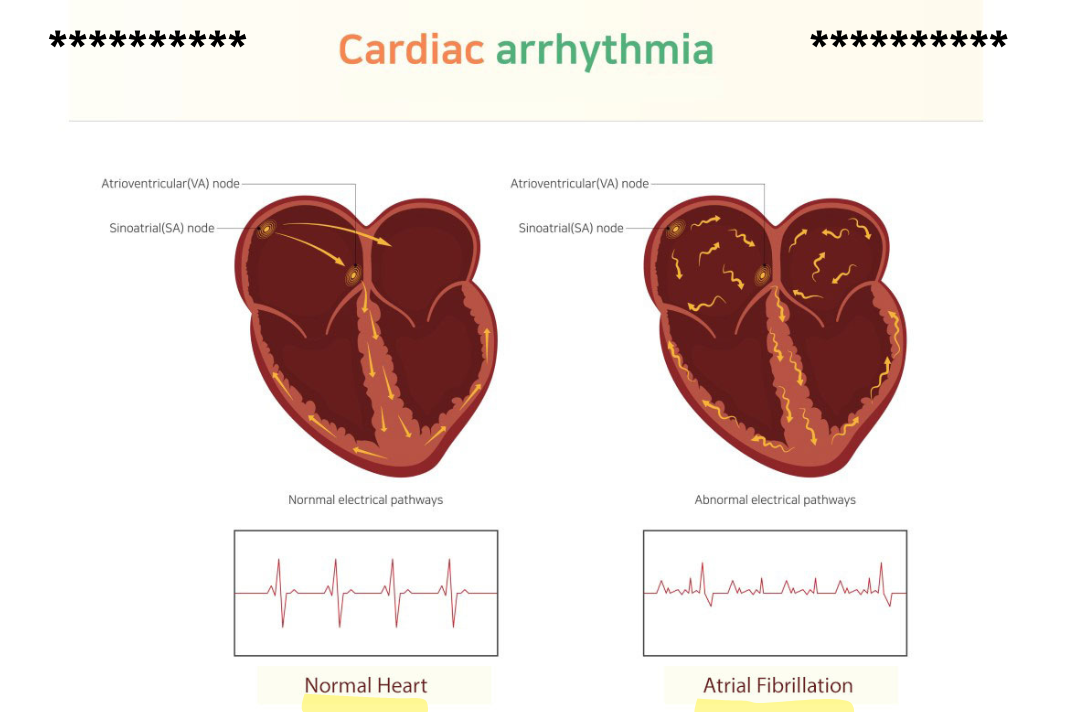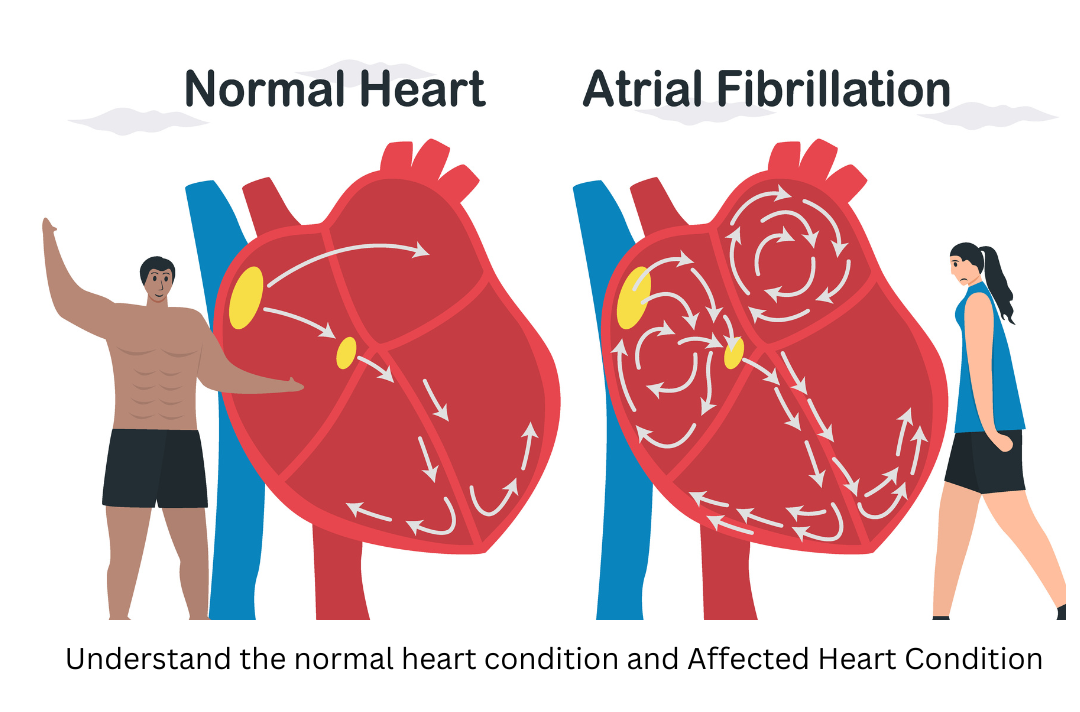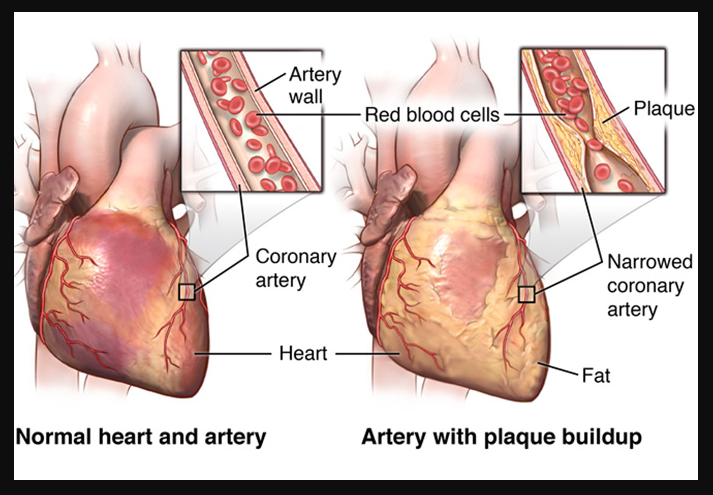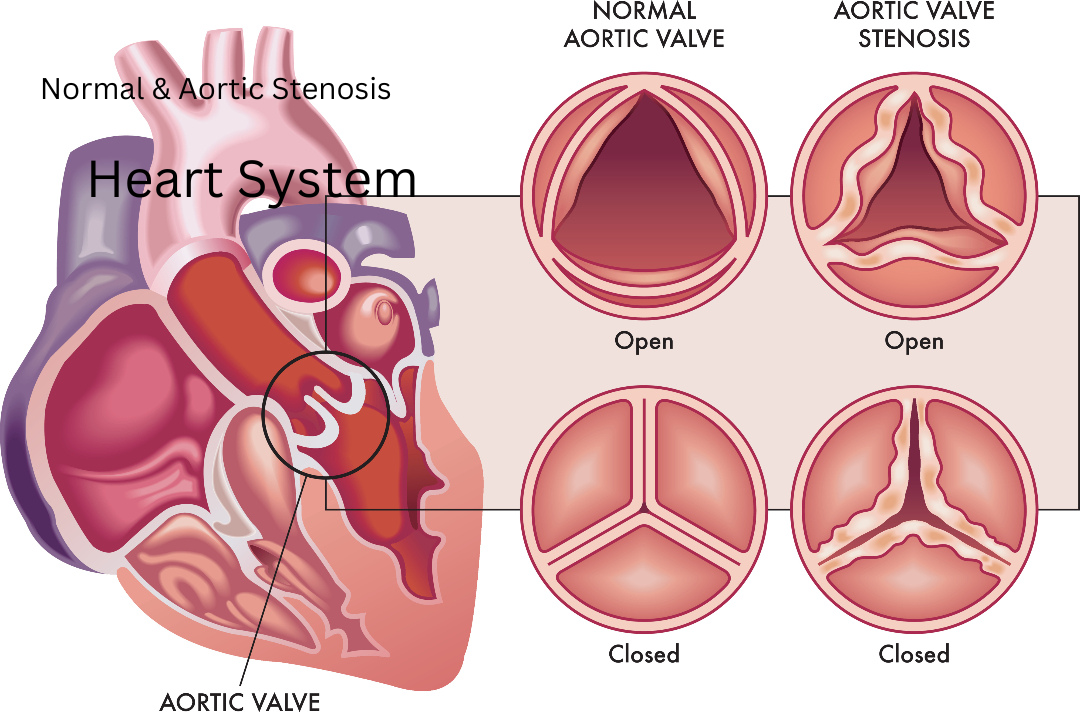Atrial Fibrillation, often known as AFib, is like a dance party where the heart’s upper chambers aren’t following the beat correctly. In simple terms, it’s a condition where the heart’s rhythm becomes irregular. Imagine the heart as a conductor, guiding the orchestra of our blood flow. With AFib, it’s as if the conductor loses control, and the musicians (our heart’s chambers) start dancing to their own tune.
During this irregular dance, the heart’s upper chambers (the atria) quiver or fibrillate instead of contracting properly. This can lead to a less effective pumping of blood, causing the heart to work harder than it should. It’s like trying to dance to a fast song when you’re out of sync with the music – things become a bit chaotic.
Doctors might diagnose AFib using tests like an electrocardiogram (ECG). If our heart were a clock, AFib would be like the second hand ticking irregularly instead of smoothly. While AFib itself isn’t a direct threat, it can lead to complications if left untreated. Understanding AFib is like learning about the rhythm of our heart’s dance, and recognizing its steps is crucial for taking the right steps toward a healthy heart.
Atrial Fibrillation Causes
Why our hearts might start dancing to an irregular beat, a condition known as Atrial Fibrillation or AFib, involves exploring the reasons behind this unexpected choreography. Let’s break down these causes in a way that’s easy for a sixth-grader to grasp.
- Aging – A Natural Choreography Shift: As we grow older, it’s like our heart’s dance choreography changes. Aging can increase the risk of AFib, making the heart’s rhythm a bit more unpredictable.
- Heart Conditions – The Dance Floor Disruptions: Sometimes, heart conditions like heart attacks or heart valve problems can disrupt the dance floor. It’s like a ripple effect, causing the heart to waltz in irregular patterns.
- High Blood Pressure – The Dance Beat Gets Stronger: High blood pressure is like a drummer playing too loudly in the heart’s dance party. It can make the atria, the heart’s upper chambers, jitter and jive in irregular rhythms.
- Thyroid Issues – The Dance Conductor’s Influence: Imagine the thyroid as the conductor of the heart’s dance. Thyroid issues can be like a maestro playing the wrong notes, influencing the heart to fibrillate.
- Obesity – Extra Weight on the Dance Floor: Carrying extra weight is like having uninvited guests on the dance floor. Obesity can strain the heart, making it more likely to start an irregular dance.
- Diabetes – The Dance Floor Glitch: Diabetes is like a glitch in the dance floor’s system. It can disrupt the heart’s rhythm and lead to AFib, making the dance less coordinated.
- Drinking Too Much Caffeine or Alcohol – The Dance Party Overdrive: Consuming too much caffeine or alcohol is like turning up the volume at the dance party. It can stimulate the heart excessively, leading to irregular movements.
- Sleep Apnea – The Dance Interruption: Sleep apnea is like an unexpected interruption during the dance. It can cause pauses in breathing, affecting the heart’s rhythm and increasing the risk of AFib.
Read.. What is Coronary Artery Disease? Check Causes, Symptoms and Treatment
Symptoms of Atrial Fibrillation
The signals that our hearts might be dancing to a different tune, a condition known as Atrial Fibrillation or AFib, involves recognizing the subtle cues our bodies give us. Let’s explore these symptoms in a way that’s easy for a sixth-grader to understand.
- Fluttering Heartbeat – The Dance’s Unpredictable Beat: Feeling a fluttering or rapid heartbeat is like sensing our heart is dancing a bit too fast. It’s a signal that the heart’s upper chambers, the atria, are not coordinating their moves properly.
- Fatigue – The Dance Floor Tiredness: Feeling tired or exhausted, especially during activities, is like our body telling us the heart is working extra hard on the dance floor. It’s a signal to take it easy.
- Shortness of Breath – The Dance Routine Becomes Breathless: Imagine dancing and suddenly feeling out of breath. Shortness of breath with AFib is like our body signaling that the heart’s dance routine is becoming a bit breathless.
- Chest Discomfort – The Dance Floor Discomfort: Experiencing discomfort or pressure in the chest is like having a sensation that something is off during the heart’s dance. It’s a signal that shouldn’t be ignored.
- Dizziness or Lightheadedness – The Dance’s Unsteady Steps: Feeling dizzy or lightheaded is like taking unsteady steps on the dance floor. It’s a signal that the heart’s rhythm might be causing a bit of imbalance.
- Difficulty Concentrating – The Dance’s Mind Distractions: Imagine trying to focus on a dance routine, but your mind is elsewhere. Difficulty concentrating with AFib is like our body signaling that the heart’s dance might be causing mental distractions.
- Sweating – The Dance’s Unexpected Intensity: Sweating more than usual, especially without a clear reason, is like the dance becoming unexpectedly intense. It’s a signal that the heart might be working harder than it should.
- Faintness or Near Fainting – The Dance’s Sudden Pause: Feeling like you might faint or experiencing near-fainting episodes is like the dance suddenly coming to a pause. It’s a signal to pay attention to the heart’s irregular movements.
Recognizing these signals is like having a special language from our bodies. If we ever notice these symptoms, it’s important to tell an adult, like our parents or a teacher, who can help us get the right support. Our body is like a messenger, and understanding these signals is a powerful way to take care of ourselves.
Treatment Approaches for Atrial Fibrillation
When our heart decides to dance to its own rhythm, a condition known as Atrial Fibrillation or AFib, it can feel a bit like a dance floor gone haywire. Understanding the steps taken to bring back the harmony involves exploring various treatment approaches that doctors might recommend.
- Medications – Helping the Heart Find its Beat: Doctors often prescribe medications to help control the heart’s dance moves. It’s like giving our heart a guiding hand to find a more regular beat. These medicines can regulate the rhythm and make the dance less erratic.
- Cardioversion – Resetting the Dance Routine: In some cases, doctors might perform a procedure called cardioversion. It’s like pressing a reset button on the heart’s dance routine. This procedure uses electrical shocks or medications to restore a normal rhythm.
- Catheter Ablation – Fine-Tuning the Dance Floor: Catheter ablation is a bit like fine-tuning the dance floor. In this procedure, doctors use a special tool to correct the heart’s irregular rhythm by targeting specific areas causing the dance to go offbeat.
- Lifestyle Changes – Adjusting the Dance Routine: Making changes in our daily routines is crucial. It’s like adjusting the dance routine to keep our hearts in sync. Staying active, eating healthy foods, and managing stress are steps to ensure the heart’s dance remains coordinated.
- Anticoagulant Medications – Reducing the Risk of Complications: AFib can increase the risk of blood clots. Anticoagulant medications are like bodyguards, reducing this risk by preventing clots from forming. These medications help keep the dance floor safe.
- Rate Control Medications – Managing the Dance’s Intensity: Rate control medications are like dance instructors managing the intensity of the dance. They help control the heart rate, ensuring it doesn’t go too fast and making the dance more controlled.
- Surgery – Refining the Dance Floor: In certain situations, surgery might be recommended. It’s like refining the dance floor by repairing or modifying parts of the heart to restore a more regular rhythm.
- Ongoing Monitoring – Keeping an Eye on the Dance: Once treatment begins, ongoing monitoring is like keeping an eye on the dance floor. Regular check-ups ensure that the heart’s rhythm stays in harmony, and adjustments can be made if needed.
Understanding these treatment approaches is like having a toolkit for our hearts. By working together with doctors and making lifestyle changes, we can help our hearts return to a coordinated and healthy dance. Just as dancers practice to perfect their moves, taking care of our hearts involves learning the right steps for a rhythm that lasts a lifetime.










helloI like your writing very so much proportion we keep up a correspondence extra approximately your post on AOL I need an expert in this space to unravel my problem May be that is you Taking a look forward to see you
Wow wonderful blog layout How long have you been blogging for you make blogging look easy The overall look of your site is great as well as the content
What i dont understood is in reality how youre now not really a lot more smartlyfavored than you might be now Youre very intelligent You understand therefore significantly in terms of this topic produced me personally believe it from a lot of numerous angles Its like women and men are not interested except it is one thing to accomplish with Woman gaga Your own stuffs outstanding Always care for it up
I do trust all the ideas you’ve presented in your post. They are really convincing and will definitely work. Nonetheless, the posts are too short for newbies. May just you please lengthen them a bit from next time? Thank you for the post.
Fantastic site A lot of helpful info here Im sending it to some buddies ans additionally sharing in delicious And naturally thanks on your sweat
Thank you I have just been searching for information approximately this topic for a while and yours is the best I have found out so far However what in regards to the bottom line Are you certain concerning the supply
Its like you read my mind You appear to know so much about this like you wrote the book in it or something I think that you can do with a few pics to drive the message home a little bit but instead of that this is excellent blog A fantastic read Ill certainly be back
hiI like your writing so much share we be in contact more approximately your article on AOL I need a specialist in this area to resolve my problem Maybe that is you Looking ahead to see you
Hi i think that i saw you visited my web site thus i came to Return the favore I am attempting to find things to improve my web siteI suppose its ok to use some of your ideas
Simply desire to say your article is as surprising The clearness in your post is simply excellent and i could assume you are an expert on this subject Fine with your permission let me to grab your feed to keep up to date with forthcoming post Thanks a million and please carry on the gratifying work
Thank you for the auspicious writeup It in fact was a amusement account it Look advanced to more added agreeable from you By the way how could we communicate
I loved even more than you could possibly be able to accomplish right here. Despite the fact that the language is stylish and the overall appearance is appealing, there is something odd about the manner that you write that makes me think that you ought to be careful about what you say in the future. In the event that you safeguard this hike, I will most certainly return on multiple occasions.
Ive read several just right stuff here Certainly price bookmarking for revisiting I wonder how a lot effort you place to create this kind of great informative website
Nice blog here Also your site loads up fast What host are you using Can I get your affiliate link to your host I wish my web site loaded up as quickly as yours lol
Somebody essentially help to make significantly articles Id state This is the first time I frequented your web page and up to now I surprised with the research you made to make this actual post incredible Fantastic job
helloI like your writing very so much proportion we keep up a correspondence extra approximately your post on AOL I need an expert in this space to unravel my problem May be that is you Taking a look forward to see you
Hi Neat post Theres an issue together with your web site in internet explorer may test this IE still is the marketplace chief and a good component of people will pass over your fantastic writing due to this problem
My brother recommended I might like this web site He was totally right This post actually made my day You cannt imagine just how much time I had spent for this information Thanks
Recently I subscribed to this fantastic website, they share useful knowledge with followers. The site owner is gifted at educating fans. I’m delighted and hope they maintain their wonderful skills.
Hello my loved one I want to say that this post is amazing great written and include almost all significant infos I would like to look extra posts like this
For the last few days I’ve been regularly visiting this wonderful site, they share awesome content for users. The site owner clearly cares about fans. I’m thrilled and hope they persist in sharing superb material.
This site is fantastic. The splendid substance shows the administrator’s devotion. I’m astounded and anticipate more such incredible substance.
I do believe all the ideas youve presented for your post They are really convincing and will certainly work Nonetheless the posts are too short for novices May just you please lengthen them a little from subsequent time Thanks for the post
Simply desire to say your article is as surprising The clearness in your post is simply excellent and i could assume you are an expert on this subject Fine with your permission let me to grab your feed to keep up to date with forthcoming post Thanks a million and please carry on the gratifying work
Thank you for the auspicious writeup It in fact was a amusement account it Look advanced to far added agreeable from you However how can we communicate
of course like your website but you have to check the spelling on several of your posts A number of them are rife with spelling issues and I in finding it very troublesome to inform the reality on the other hand I will certainly come back again
Hello i think that i saw you visited my weblog so i came to Return the favore Im trying to find things to improve my web siteI suppose its ok to use some of your ideas
certainly like your website but you need to take a look at the spelling on quite a few of your posts Many of them are rife with spelling problems and I find it very troublesome to inform the reality nevertheless I will definitely come back again
I do not even know how I ended up here but I thought this post was great I dont know who you are but definitely youre going to a famous blogger if you arent already Cheers
Can you be more specific about the content of your article? After reading it, I still have some doubts. Hope you can help me.
you are truly a just right webmaster The site loading speed is incredible It kind of feels that youre doing any distinctive trick In addition The contents are masterwork you have done a great activity in this matter
Can you be more specific about the content of your article? After reading it, I still have some doubts. Hope you can help me.
certainly like your website but you need to take a look at the spelling on quite a few of your posts Many of them are rife with spelling problems and I find it very troublesome to inform the reality nevertheless I will definitely come back again
What i do not understood is in truth how you are not actually a lot more smartlyliked than you may be now You are very intelligent You realize therefore significantly in the case of this topic produced me individually imagine it from numerous numerous angles Its like men and women dont seem to be fascinated until it is one thing to do with Woman gaga Your own stuffs nice All the time care for it up
I just could not depart your web site prior to suggesting that I really loved the usual info an individual supply in your visitors Is gonna be back regularly to check up on new posts
Hello my loved one I want to say that this post is amazing great written and include almost all significant infos I would like to look extra posts like this
obviously like your website but you need to test the spelling on quite a few of your posts Several of them are rife with spelling problems and I to find it very troublesome to inform the reality on the other hand Ill certainly come back again
Your point of view caught my eye and was very interesting. Thanks. I have a question for you.
Your point of view caught my eye and was very interesting. Thanks. I have a question for you.
Can you be more specific about the content of your article? After reading it, I still have some doubts. Hope you can help me.
Hi Neat post Theres an issue together with your web site in internet explorer may test this IE still is the marketplace chief and a good component of people will pass over your fantastic writing due to this problem
Hello i think that i saw you visited my weblog so i came to Return the favore Im trying to find things to improve my web siteI suppose its ok to use some of your ideas
Wow amazing blog layout How long have you been blogging for you made blogging look easy The overall look of your web site is magnificent as well as the content
Just wish to say your article is as surprising The clearness in your post is just cool and i could assume youre an expert on this subject Fine with your permission allow me to grab your RSS feed to keep updated with forthcoming post Thanks a million and please keep up the enjoyable work
Your blog is a testament to your dedication to your craft. Your commitment to excellence is evident in every aspect of your writing. Thank you for being such a positive influence in the online community.
Just wish to say your article is as surprising The clearness in your post is just cool and i could assume youre an expert on this subject Fine with your permission allow me to grab your RSS feed to keep updated with forthcoming post Thanks a million and please keep up the enjoyable work
Hi i think that i saw you visited my web site thus i came to Return the favore I am attempting to find things to improve my web siteI suppose its ok to use some of your ideas
olá, gosto muito da sua escrita, então compartilhe, mantemos uma correspondência extra sobre sua postagem na AOL. Preciso de um especialista nesta casa para desvendar meu problema. Talvez seja você. Olhando para frente para vê-lo
What i dont understood is in reality how youre now not really a lot more smartlyfavored than you might be now Youre very intelligent You understand therefore significantly in terms of this topic produced me personally believe it from a lot of numerous angles Its like women and men are not interested except it is one thing to accomplish with Woman gaga Your own stuffs outstanding Always care for it up
Hello Neat post Theres an issue together with your site in internet explorer would check this IE still is the marketplace chief and a large element of other folks will leave out your magnificent writing due to this problem
I have read some excellent stuff here Definitely value bookmarking for revisiting I wonder how much effort you put to make the sort of excellent informative website
O que eu não entendo é na verdade como você não é realmente muito mais querido do que é agora Você é muito inteligente Você sabe, portanto, significativamente no caso deste tópico que me produziu individualmente, imagine-o de vários ângulos diferentes É como homens e mulheres não pareça fascinado até que seja algo a ver com Mulher gaga Suas próprias coisas são legais Todo o tempo cuide disso
Simply wish to say your article is as amazing The clearness in your post is just nice and i could assume youre an expert on this subject Well with your permission let me to grab your feed to keep updated with forthcoming post Thanks a million and please carry on the gratifying work
Hi i think that i saw you visited my web site thus i came to Return the favore I am attempting to find things to improve my web siteI suppose its ok to use some of your ideas.
Batida magnífica, gostaria de aprender enquanto você altera seu site, como posso me inscrever em um blog? A conta me ajudou a um acordo aceitável. Eu estava um pouco ciente disso, sua transmissão ofereceu uma ideia brilhante e clara
Disposable vape Products bundles typically come with a fully charged battery. This means you can start vaping immediately without the need to worry about charging cables or finding power outlets.
Hi Neat post There is a problem along with your website in internet explorer would test this IE still is the market chief and a good section of other folks will pass over your magnificent writing due to this problem
Wow wonderful blog layout How long have you been blogging for you make blogging look easy The overall look of your site is great as well as the content
Wow superb blog layout How long have you been blogging for you make blogging look easy The overall look of your site is magnificent as well as the content
I do not even know how I ended up here but I thought this post was great I do not know who you are but certainly youre going to a famous blogger if you are not already Cheers
Thanks I have just been looking for information about this subject for a long time and yours is the best Ive discovered till now However what in regards to the bottom line Are you certain in regards to the supply
Somebody essentially lend a hand to make significantly posts I might state That is the very first time I frequented your web page and up to now I surprised with the research you made to create this particular put up amazing Excellent job
Hi Neat post Theres an issue together with your web site in internet explorer may test this IE still is the marketplace chief and a good component of people will pass over your fantastic writing due to this problem
helloI like your writing very so much proportion we keep up a correspondence extra approximately your post on AOL I need an expert in this space to unravel my problem May be that is you Taking a look forward to see you
Its like you read my mind You appear to know a lot about this like you wrote the book in it or something I think that you could do with some pics to drive the message home a little bit but instead of that this is fantastic blog An excellent read I will certainly be back
Your blog is a treasure trove of valuable insights and thought-provoking commentary. Your dedication to your craft is evident in every word you write. Keep up the fantastic work!
The article was a delightful read, and The passion shines as brightly as The intellect. Quite the combination!
The research depth is so evident, I almost thought this was a thesis defense.
Packed with insights, or what I call, a buffet for the brain.